NEONATOLOGY ON THE WEB
Premature and Congenitally Diseased Infants
by Julius H. Hess, M.D.
Chapter IX
Incubators
The History of Incubators -- The first records of the use
of incubators are found in description of their employment for the
hatching of eggs of fowls in Alexandria, and it is possible that it
may have occurred to the Egyptians to apply this method to the new
born. One cannot, however, assume this, for no author of that period
has mentioned it. Hippocrates, in his writings of 460 B.C., makes the
following statement: "No fetus coming into the world before the
seventh month of pregnancy can be saved." We note that the literature
of our day records only a limited number of exceptions to these
conclusions that infants before the end of the twenty-eighth week are
viable.
Pasquad quotes a thesis of the Eleventh Century of the Republic
wherein the author, Rudellet, writing on the vitality of infants,
reports the following which we think well worth citing. He quotes
from Baillet (Decisions of Savants, Paris, 1722) as follows:
"Among the records of celebrated children Baillet reports that of
Fortunio Liceri, whose mother gave birth to him long before the
ordinary time during the fatigues and shocks of a sea voyage. This
fetus was no larger than the palm of your hand, but his father who
was a physician, having examined it, had carried it to the place
which was to be the end of his voyage. There he had other physicians
see it. They found that there was lacking nothing essential to life,
and his father undertook to finish Nature's task and to work at the
formation of the child with the same skill that men exhibited in
hatching chickens in Egypt. He instructed a nurse in all that she had
to do in the maintaining of exactly measured artificial heat and the
requirements for his general care and feeding. He lived to be
seventy-nine years of age and distinguished himself in science by a
large number of works."
This is a tale the recording of which leads us to believe that use
was made of the knowledge of the methods used at that age in
incubating fowls. We will dispense with any remarks and will content
ourselves with mentioning the fact, in citing the reflection of the
historian himself: "One must admit," says the author in concluding
the narrative of which we have just given the analysis, "that all
which is unbelievable is not always false, and that probability is
not always on the side of truth."
Little is recorded from 1722 to 1857, the time when Denucé
described his incubator. Modern French writers attribute the origin
of the first incubator to Denucé, of Bordeaux, who in 1857
described his model which consisted of a double-walled tub which was
to be filled with warm water at intervals (Fig.
130).
Clementovsky states that a somewhat similar contrivance was used
by Rühl in St. Petersburg as early as 1835.
Credé, in 1866, published the results which he obtained
with a similar apparatus which had been in use in his clinic in
Leipzig since 1860, with the use of which he was able to lower his
mortality by 18 per cent. This simple tub has bee modified by some of
the continental clinicians by putting it on a stand and providing it
with a hose attachment for connection with a hot-water faucet
(Fig. 131).
In 1879 Winckel described a permanent bath in which the infant
floated. This apparatus was an attempt at imitating intra-uterine
conditions, but needless to say, because of the danger of drowning
and infection, it proved unpopular. The water in this tub was kept
between 36° and 38° C.
In 1860 Tarnier had an infant incubator constructed similar to
those used as chicken incubators. This incubator was built for him by
Odile Martin, director of the Paris Zoo, and was built of such size
that it could hold several children; and was installed in the
Maternity Hospital of Paris in 1881 (Fig.
132).
This is the first closed incubator which may be qualified as
modern, for the perfected apparatus of our day differs from it only
in detail.
This is the time that dates the principal work undertaken on
incubator construction, and the most varied modifications have
followed each other almost without interrupt until our day.
The most important work on the results obtained by their use is an
account by Auvard in 1883. In this interesting work the author gives
the first statistics on the use of the incubator in the Maternity in
this period under the scientific direction of Tarnier.
Berthod, an interne of Tarnier, in an excellent thesis (1887),
continued this study, adding thereto some new data on the conditions
indicating the use of an incubator for the new-born infant. His
statistics are still most imposing, and they treat upon almost a
thousand cases in which the incubator was used. Among the most
influential of these was Budin.
The monographs of Auvard and Berthod are the only two important
early works treating of the study of incubators and the results of
their use. Their work shows the importance of the prevention of
hypothermia, and they lay particular stress upon the protection of
the infant from the moment of its birth. It may be stated with
justice that the early progress in the care of premature infants was
to a great extent influenced by the interest of the French
obstetricians in the care of these infants.
Since then a large number of authors have written on this subject,
but it is rather to modify certain details or to propose new forms of
apparatus than to give new rules.
From that time on until our day the incubator has undergone
changes -- some quite radical, while some have remained as
rudimentary as when first originated.
Only those models demonstrating more important changes and
improvements will be described.
Hearson introduced automatic temperature regulation within the
incubator. His apparatus was so constructed as to set off an electric
alarm clock when the maximum temperature desired was past. This
apparatus was modified by Eustache who attempted to attach automatic
gas or oil-heating apparatus to the so-called "thermostat nurse of
Hearson."
In 1896 Diffre, of Montpelier, and Lion built metal incubators,
providing for what they termed final perfection which provided for
automatic heating through thermostat control, the heat being
furnished through a hot-water system heated by an oil or gas stove at
the side of the incubator. In this incubator refinements in
ventilation and control of humidity were introduced.
A giant incubator was prepared by Prof. Pajot, in 1885, for use in
his clinic, consisting of a large heated chamber, practically an
oven; the congenitally feeble infants, entirely separated from their
mothers, being fed and tended by wet-nurses.
Budin, in stating the disadvantages of the Pajot apparatus, said:
"The wet-nurses were obliged to feed and tend the infants in this
oven; and the mothers, separated from their infants, soon lost all
interest in those whom they were unable to nurse and cherish. It is
better by far to put the little one in an incubator by its mother's
side."
Prof. Hutinel, of Paris, whose studies on the subject are of
interest, constructed a couveuse composed of a boat-like vessel of
enameled crockery whose bottom was replaced by a plate of galvanized
sheet-iron pierced by holes. The plate served as a cover to a metal
box, which contained three bowls filled with hot water. The top of
the apparatus was closed by a heavy glass which could be raised to a
desired degree by the aid of a screw, and which allowed the airing of
the box. The water bowls were replenished every two or three hours to
maintain the temperature. The crockery tub could be disinfected with
ease by wiping it with a cloth saturated with bichloride of mercury
solution, which was its best feature.
Simple and cheap in its operation is Finkelstein's incubator. The
essentials of its construction may be seen from the accompanying
illustration (Fig. 133). The
circular holes in the side walls of the box for inserting hot-water
vessels also serve as inlets for the incoming air, while the used air
escapes through the holes at the upper part near the cover.
Rommel's apparatus proved to be good and is at the same time like
the latter easily carried from one place to another (Fig.
135). The chamber is 0.83 cubic meter large, enclosed on three
sides by mirror glass, the corner being rounded to facilitate
cleaning. The ventilating shaft permits the air to be renewed 100 to
120 times every hour. The humidity regulation is simple. The large
supply of hot water of about 15 to 20 liters permits a pretty
constant temperature, the fluctuations according to Rommel being less
than 1°. For heating electric incandescent lamps are used.
Moll's incubator (Fig. 138)
distinguishes itself by the fact that the head of the infant remains
outside the warm box and breathes the air of the room, this having a
great advantage for respiration of debilitated infants, since,
because of stronger respiratory stimulus, attacks of asphyxia may be
more easily avoided.
To this class of incubators, which are all modifications of the
original Lion type, belong the models of Couney, DeLee and others now
on the market in the United States (Fig.
136 and 137).
These models differ but slightly in principle, the chief variation
being in the manner of heating and distributing the air and supplying
moisture. They may be heated by gas or oil stoves situated at the
side of the incubator, heating air as it enters, or by a system of
electric bulbs within the incubator. In the latter models the bulbs
are usually located either in the floor or sides. The best models are
those in which the heating system is modelled after that used in
hot-water heating plants for houses. The temperature is automatically
controlled by a thermostat.
A thermometer is fastened near the side window, so that it may be
easily read, and a hygrometer is used to indicate the degree of
moisture.
This type of incubator has in the past ten years lost considerable
of its early popularity, as is evidenced by a visit to most of the
large hospitals. A great deal of this deserved unpopularity is due to
the inability to ventilate them in the ward and the necessity for
furnishing a trained assistant. To properly supply these incubators
with a free current of air it is necessary to connect them so that
they will receive a supply of air from outside of the building. To
counteract the tendency to an insufficient air current in the absence
of windows or when they are in the wrong direction an electric fan
should be incased on the outside of the building in such position
that air may be blown directly through the incubator. This is
difficult of arrangement when the incubators are located above the
first floor of the building. When the station is located on the first
floor it is necessary to avoid the dampness and dust of the street
level, and this can be accomplished by installing a large funnel 15
or 20 feet above the ground level, some 24 to 36 inches in diameter,
to which is attached a 10-inch stack which can be connected with a
cage at its base in which the electric fan is installed. From this
point the air is blown through the system of incubators.
When such a considerable quantity of air is blown into the
incubator system, it becomes necessary to filter it through several
layers of cotton. This is best done at the side of the individual
incubator.
The Cincinnati Hospital uses an electrically heated bassinette.
The temperature is regulated by a series of electric lamps under the
mattress. The appartus consists of a double wall frame, with hot air
rising in this double wall and escaping through small holes near the
top which can be opened or closed as required by a slide damper.
In 1914 the writer designed an electric heated water-jacketed
infant bed.
It combines the double-wall water jacket with insulation to
prevent external loss of heat, and electric heating by a large plate
with rheostat control.
For hospital and home equipment the bed answers many requirements,
because of its simplicity of operation in any well-ventilated and
moderately heated room.
It can be used for the care of premature infants, for the
protection of the new-born full-term infant immediately after
delivery and for infants suffering from hypothermia from other
cauess.
This bed fulfils the following needs of the infant: (1)
Safety. The maximum temperature which can be obtained within
the bed is about 110° F. when the lid and canopy are in place
with a room temperature of 70° F. While such a temperature would
be injurious if maintained for a long period of time, such
surroundings if temporary can cause but little injury. (2)
Simplicity of operation. It requires practically no attention
unless there are extreme ranges of temperature within the ward, since
the asbestos insulation prevents radiation from the outer surface of
the bed and the heater holds the water at a constant temperature. (3)
Ventilation. This apparatus assures the baby of an adequate
supply of fresh air if placed in an ordinary room which is well
ventilated. (4) Humidity is maintained at nearly the same
degree as the surrounding air because of the almost constant change
of air within the bed and moisture supplied by an evaporation pan
beneath the crib. (5) It is easily cleaned and disinfected.
The construction of the bed is such that it can be used in an
ordinary ward or room, giving the infant the advantage of a most
perfect room ventilation.
The following suggestions will aid in the practical application of
this bed for use in hospitals or the home.
A special room should be provided. This has a practical advantage
as it impresses the nurses to consider this room as barriered. This
will make a demand upon the nursing staff for observation of all of
the rules of aseptic nursing.
This room should be supplied with an ample system of heating coils
controlled by a thermostat for winter use, thereby facilitating the
maintenance of a more or less stable temperature in the room which
should, in so far as possible, range between 68 and 75° F.
The temperature within the room and bed should be read and charted
at six-hour intervals, best at 6 A.M., 12 M., and 6 and 12 P.M. as
the most likely time for maximum changes in the ward temperature.
Ventilation should be adequate but not excessive, and the
room should be so constructed that the beds may be placed without the
line of direct air currents. This is accomplished by having the
ventilating windows and transoms on one side of the room, while the
opposite side is built with non-ventilating windows or blank walls at
either end.
Humidity in so far as the room is concerned will require
little attention except at such time when considerable artificial
heating is necessary. To supply the needed moisture during cold water
when ventilation of the room is more or less limited, a large
evaporating pan should be in direct contact with the radiator coils.
When these means fail to furnish the desired moisture, a wet sheet
may be hung in the room and remoistened as indicated by the
hygrometer.
In so far as possible the relative humidity should be kept at
about 55 per cent. However, amounts less than this down to 45 per
cent will usually cause little or no discomfort or retardation of
progress. It has been our experience that with a good free
ventilation through open transoms or windows when the temperature of
the room does not exceed 80° F., the normal water content of the
air is quite sufficient and little or no attempt at influencing the
room humidity is necessary. However, this will not answer the purpose
where a closed room is used.
When a special room cannot be provided the beds for well
prematures should be kept in the nursery used for normal infants.
They must never be brought into contact with infected infants because
of the danger of crossed and mixed infections. Neither should
infected prematures be placed among well new-born infants.
All infants should be removed from this room to the nursery once
daily, so that it may be thoroughly ventilated and cleaned by the use
of soap and water. Before replacing the infants the air should be
reheated to remove excessive humidity.
Care of the Bed
General Care. -- Once daily the infant should be removed
from the bed to allow of cleaning the interior with a damp cloth.
This is best done at the time of renovating the room. The crib itself
should also be wiped with a damp cloth. All linens should be changed
at once daily and at other times when soiled. Extra mattresses should
be supplied so that they may be given an airing on alternate days and
a thorough renovating as frequently as soiled. Renovation is
imperative between cases. Mattresses should be protected by rubber
sheeting. A thick pad, however, must be placed between the rubber
sheeting and the infant.
The heating apparatus consists of a plate with a 6-inch
surface in direct contact with the floor of the water jacket, and
especially constructed to carry a maximum capacity of 300 Watts,
which makes it impossible to heat the water above 155° F. and
the interior of the bed above 110° F. at a room temperature of
70° F.
A rheostat with seven contacts is fastened to the standard. Six of
them are graduated to take current varying from 25 Watts on contact 1
to 300 Watts on contact 6. The first contact shuts off the current.
For the protection of very frail infants a partial cover for the
tub, 21 1/2 inches in length, is provided to shield them more
completely from outside air currents. It is provided with a
thermometer, so that the temperature within the tub can be
ascertained by the nurse at all times. Further, a brass nickel-plated
frame covered by a removable linen cover is provided in the form of a
hood. This can be set over the open space not covered by the metal
lid in case of great air currents and extremely cold nights. This
allows a free circulation of air to enter at the front of the canopy
while at the same time preventing direct downpour of cold air onto
the infant's head. The hood raises the temperature within the bed on
an average of from 5° to 10° F., depending on the room
temperature and current used, but does not interfere with perfect
ventilation. The hood is made collapsible, and may be set at any
angle desired, as may be indicated.
The hood is used in combination with the lid for very small
or frail infants when a high temperature is desired or when the room
temperature is more or less beyond our control, because of a
defective heating system or extremely cold weather. Both are used
when it is desired to heat this bed rapidly in an emergency.
The removable metal lid, which also holds the thermometer
for temperature reading, is used alone for most cases, the length of
time varying from a few days to several weeks. The hood and lid are
both left off for the more mature cases and those being prepared for
graduation from the heated bed to the nursery or home.
With the lid on it is rarely necessary to pass contact 4 of the
rheostat to obtain a temperature of 90° F. in a room
approximating a temperature of 70° F. When it is desired to heat
the bed rapidly preparatory to its use, the rheostat may be set at
point 6 with the hood and lid on until the bed is heated to the
temperature that may be needed when it may be returned to points 2,
3, or 4, depending upon the fetal age and development of the infant.
As the infant develops it should be gradually prepared for
graduation from the incubator by lowering the temperature of the bed
by degrees to that of room temperature. This may cover a period of
several days or weeks. At this time the lid may be removed. We have
found it of advantage to remove the lid of the bed when the infant
has developed sufficiently to thrive in the room temperature of
75° F., after which the temperature of the bed with the lid off
can be left a few degrees above the room temperature by advancing the
rheostat by one or two points. The temperature of the bed is now
measured by placing a thermometer alongside of the baby within the
sleeping bag or under the blanket.
It is our custom to cover the infant when in the bed with a light
sleeping bag or light woolen blanket, in order to more completely
stabilize its body temperature, as our beds are kept in a
well-ventilated room. The sleeping bag should either be fitted with a
flap, which can be used as a hood or a small bonnet should be warn or
the blanket should be so applied so that it can be used as a head
cover. Outer garments or covers should be applied loosely so as to
allow of free movements of the extremities.
In order to use the bed rationally it is necessary to have an idea
of the effect of the various factors influencing the crib
temperature. To this end the following observations are offered for
the guidance of the attendant.
Comparative Measurements of
Temperature in Heated Bed
Under Different Conditions
The temperature as read from the lid thermometer and that of a
thermometer placed alongside the infant under a light blanket used
as a cover will show variations which rarely exceed 1 to 3°
F. at a room temperature varying between 70° and 80° F.
The lid temperature will approximate the following:
Lid and Canopy On. -- 10° F. above the room
temperature when on contact 2; 15° F. above the room
temperature when on contact 3; 20° F. above the room
temperature when on contact 4; 25° F. above the room
temperature when on contact 5; 30° F. above the room
temperature when on contact 6.
Lid On and Canopy Off -- 5° to 10° F. above
the room temperature when on contact 2; 10° F. above the room
temperature when on contact 3; 15° F. above the room
temperature when on contact 4; 20° F. above the room
temperature when on contact 5; 25° F. above the room
temperature when on contact 6.
Lid and Canopy Off -- The temperature alongside of the
infant under its blanket will average from 5° to 10° F.
higher than the room temperature on contacts 2, 3, 4, 5, and 6
with a room temperature between 70 to 80° F.
As in all other care of these infants individualization should be
the watchword and only by a careful observation of weather and
temperature changes can the best results be obtained.
The maintenance of desired temperature for a given case resolves
itself into a very simple problem if the above facts relating to the
recording of the lid temperature is borne in mind, in that the only
variable factors are the room temperature and air currents. The
former in most hospital rooms will average from 65 to 75° F.
throughout most of the day, and the ventilation of the room can
easily be controlled. In most cases it is only necessary to change
the rheostat one or two points at the extremes of the day, as at
midnight when the temperature is likely to fall, and in the morning
when the hospital temperature is again more uniform.
We require recording of the temperature of the room and bed at 6
A.M., 12 M., 6 P.M., and 12 P.M. In order to insure safety from
extreme heat currents and extreme fluctuations in room temperature
the point of the rheostat ward temperatures and humidity should also
be recorded at these times (Fig. 88).
The degree of temperature to be maintained within the bed must of
necessity vary with the individual infant and be dependent in part
upon the infant's physical temperament. We rarely find it necessary
to maintain a temperature above 90° F. for more than a limited
number of hours even in extreme cases. In small infants it may be
necessary to hold the temperature between 85 and 90° F. for
several days. Most infants, after a few days, do best in a
temperature ranging between 75° and 80° F., depending upon
their development. An average of 76° to 78° F. will answer
the latter needs of the better developed infants. It may be stated
that fluctuations of 3° to 5° F. in the temperature in the
bed during the course of the day have little detrimental influence on
the infant's progress. Marked fluctuations are extremely dangerous
(Fig. 142).
Ventilation. -- Ventilation within the bed is maintained
automatically when the bed is heated. This is due to the fact that
the air in the center of the bed is cooler than at the side walls,
thereby causing the cooler air to pass into the bed at its center,
then to flow to the floor, along the floor, to the side walls and
then up and out at the sides. The direction of the air currents
within the bed has a double advantage in that the infant receives the
renewed fresh air for breathing while it is surrounded by the warmed
air.
Humidity. -- Excessive drying of the air is prevented by
the constant circulation through the bed of the free air of the room
and by evaporation from a flat basin, containing baked porous clay
(as used in water filters), over which water is poured to allow of
evaporation. This is placed on the floor of the bed immediately under
the baby basket. Varying with the degrees of temperature to be
maintained within the bed, it is necessary once daily to supply from
8 to 16 ounces of water to replace that lost through evaporation.
Dangers. -- The dangers in the use of any heated bed which
must at all times be avoided to insure success are:
1. Overheating and Refrigeration. -- Reading and recording
of the room temperature, the rheostat contact and the bed thermometer
at regular intervals throughout the day will furnish the necessary
data to avoid these dangers.
2. Water Hunger. -- Fluids must be supplied to an amount
not less than one-sixth to one-eighth of the infant's body weight
every twenty-four hours as early as possible following birth. (See
Feeding, p. 181.)
It is, therefore, necessary to control the temperature,
ventilation and humidity of the bed, and to keep a careful
supervision of the feeding, more particularly the fluid intake.
Respiration must also be carefully watched in order to detect
cyanosis and asphyxia sufficiently early to save the infant. This
requires that these infants be observed day and night.
No attempt should be made to prevent heat loss entirely by keeping
the air surrounding the infant at anywhere near its body temperature.
Leaving an infant in such an environment would soon result in heat
stagnation with resulting symptoms of heat stroke which is early
evidenced by restlessness, rapid respiration and dry skin.
The bed temperature should be lowered gradually but steadily until
it reaches 72° F. The best method of judging the infant's
external temperature requirements is by taking the rectum temperature
at stated intervals. The infant should be graduated from the
incubator as soon as its general condition permits. It should then be
kept in a clean, well-ventilated room, in which the temperature can
be stabilized at about 70° F. The average time that a higher
surrounding temperature will be indicated will vary between one and
eight weeks and the hospital stay from two to ten weeks. "Mothering,"
in the form of exercise, and massage are essential to every premature
once its physical condition permits handling. The same is true of
needs for the strictest attention to its personal hygiene.
The infant should be discharged to its home as soon as possible
for several reasons: (1) In a good home environment it will receive
more individual care than in a general hospital; (2) the interest of
the mother in the child must be maintained; (3) placing the infant at
the breast is the best way of maintaining the mother's milk supply,
if the breasts are still actively secreting; (4) in order to prevent
"hospitalism" due to lack of "mothering" and a tendency to secondary
infections.
The bed must be kept scrupulously clean.
The infant's bedding should be of such material that it can be
destroyed when contaminated by vomit and excreta. Feathers are not
practical. Untarred jute can be used for this purpose. The mattress
should be covered by a heavy pad to prevent soiling.
All contact with infected cases and attendants must be avoided.
All visitors are best excluded.
The conservation of heat must begin immediately after birth.
The infant must be properly dressed; its head as well as its body
should be protected.
The body temperature of the infant should not be allowed to go
lower than 97° nor above 98.6° F. Daily fluctuations
greater than 1.5° F. are dangerous.
The general care and feeding should receive the most careful
attention.
Above all else care administered to the premature should tend to
individualization.
Home-Made Heated Beds
Emergency Equipment. -- As many of the cases must be cared
for in the home and in most instances without time or facilities to
properly equip a nursery, every physician should have some definitive
ideas on the construction of a bed which will meet exigencies of the
individual case. We have already spoken of the general care and
equipment of a nursery unit in the home. A number of practical
emergency beds have been described, the specifications of a few of
which will be given more in detail.
A small wash basket well padded inside and outside by
quilting, into which is fitted a removable platform about 4 inches
above the padded floor of the basket, makes a fair emergency bed.
Beneat the platform in the floor of the basket hot-water bottles or
bags are placed which must be refilled from time to time. The removal
of the bags for refilling, which should be three or more in number
and which are to be filled at different times, is facilitated by
cutting an opening along the lower outer wall of the basket through
which the water bags can be removed at will without disturbing the
infant. A box can be built for this purpose to even better advantage.
Whether a box or basket is used it must be provided with some form
of cover for three-quarters of its upper surface. This may be
accomplished by using a heavy blanket or building a lid to fit.
In such a bed the infant must be provided with proper clothes as
previously described to prevent undue heat loss.
This bed should be kept in a well-ventilated warm room, the
temperature of which should range between 68° and 72° if
possible.
Brown [26] describes the following practical home-made
heated bed:
Take a 24-inch wicker clothes basket and pad the bottom with
non-absorbent cotton to a depth of 8 inches. On top of this cotton
fit a sheet of oilcloth, sewing the edges through the sides of the
basket. On the oilcloth lay a double layer of white flannel and on
the flannel a napkin of absorbent cotton. Take half a dozen of
12-ounce citrate of magnesia bottles with wire and rubber corks and
cover them with flannel. These bottles are filled with water at
110° F. and hung on the inside walls of this basket. A
thermometer hung inside should register a temperature from 80°
to 90° F. all the time. At night an oilcloth is spread over the
foot half of the top of the basket.
Electric-heating pads, protected by copper jackets, have
been in use by the writer over a period of several years, and offer a
valuable means of meeting emergency requirements. They are also
valuable for use in the home where the temperature cannot be well
regulated after infants leave the hospital station. Electric-heating
pads have lost their popularity through the danger of fire following
short circuit due to broken wires, and through the poor quality of
the thermostat attachments of some of the pads. To avoid the danger
of fire from short circuits in electric-heating pads, a copper
receptable is used, 16 inches long, 13 inches wide and 1 1/4 inches
high, into which a 12 x 15-inch heating pad is laid. To allow of a
maximum radiation from the lid or upper surface of the same, the
floor and sides are lined with asbestos sheeting, while the lid is
not lined. The cord passes through a small rubber insulator at the
side to prevent contact with the metal and injury to the cord. This
simple device can be used temporarily in wards and homes where better
facilities for care of this class of infants are lacking. It is to be
placed in the bottom of a basket or crib, under the mattress or
pillow (Fig. 143).
Litzenberg [27] has described a practical bed for home or
hospital use for which the specifications are as follows. A box 24
inches long, 20 inches high, 18 inches wide. Eight inches from the
bottom is a false bottom dividing the box into two chambers, the
heating apparatus being in the smaller lower chamber and the baby in
the upper one. The false bottom is the support for the bed of the
baby and does not cover the whole bottom of the box, a space of 4
inches being left at one end for the circulation of hot air. The top
of the box may be fixed on hinges, or to slide, which is better.
There is a pane of glass in the top so that the baby may be watched,
and there are two ventilating holes near the end of the cover
opposite the place where the hot air enters. An ordinary pillow is
laid on the false bottom for the bed. The incubator is heated by
bottles filled with very hot water and placed in the lower chamber
through a small door in the side of the chamber. Fresh air enters
this door, passes over the hot bottles, is heated and ascends by way
of the 6-inch space at the end of the box to the baby's chamber and
out through the ventilating holes in the top, giving a constant
supply of warm fresh air. A thermometer is placed in the incubator
beside the baby, or better beneath the first fold of the enveloping
blanket.
By watching this thermometer a fairly constant temperature can be
maintained by frequent filling of the bottles. This is the method
usually advised for heating. He has further devised a hot-air
radiator made of ordinary 3-inch eaves-spouting. A temperature not
varying 2 to 3° F., he states, is easy to maintain. The heat
from the chimney of an ordinary lamp enters the spout radiator
through an elbow 1 inch or 2 above the chimney. This elbow curves
upward toward the box, which it enters by way of a hole in one end of
the chamber where the spout divides into two parts to give more
radiating surface. These two branches unite at the other end of the
box, and the warm air passes out through a hole in the end without
entering the chamber in which the infant is placed. Thus, the
products of combustion in the lamp do not enter to injure the baby.
The air for the baby enters by the door in the side of the box
described before, and is heated by the hot pipes and ascends to the
baby. Over the discharging end of the radiator is a cap with a hole 1
inch in diameter. This discharge hole being very small, keeps the hot
air from rushing through without radiating its heat. The box can
easily be made collapsible so that the whole thing can be slipped
under the seat of a buggy and be set up complete in less than five
minutes.
Specifications. -- Board 1 inch thick, 10 inches wide and
21 feet long. Cut six pieces 2 feet long and one piece 18 inches
long. On four of the 2-foot pieces nail a small cleat, the full width
of the board, 1 inch from each end. Eight inches from the edge of two
of the 2-foot pieces nail a cleat parallel to the long way of the
piece and on the same side of the piece as the small cleat. In the
center of the 18-inch piece cut a hole 3.25 inches in diameter. Now
set the pieces with the long cleat on edge. The cleats will face each
other and be eight inches from the floor. Place one of the 18-inch
pieces with the hole in it against the end cleats of the two side
pieces and fasten them there by means of two hooks screwed into the
short edge of the side pieces, the hook fastening in a staple or ring
in the 18-inch piece. Fasten the other end in the same manner and
then place the radiator in the two holes in the end. Now lay two of
the 18-inch pieces in the long cleat, and you have the false bottom
or bed support. The other 2-foot pieces with the cleats are now put
together with the two remaining 18-inch pieces with hooks arranged as
described, and when put together they are placed on top of the first
set and securely fastened, thus making a box 18 x 20 x 24 inches.
There now remain two of the 2-foot pieces which are fastened together
with several cleats to make a top. A hole about 8 x 10 inches is cut
near one end of the top for a window for observing the child, and
still nearer the end are cut two ventilating holes about 2 inches in
diameter.
Room Incubators
The room incubator or so-called giant incubator claiming to
have all the advantages of little incubators without their
inconveniences, was constructed in Lyon, France, for the first time
in 1886 by H. Colrat. It consisted of a room 12 feet long and 8 feet
wide. Its two main features were an attempt to hold a constant
temperature, and a system of aeration permitting of renewing the air.
It was, no doubt, a good innovation at that time.
In 1900 Arnaud, of Turin, introduced the hot-air room, and it
found followers in other cities.
The incubator chambers built by Escherich and Pfaundler in Graz
and Vienna, Brauer in Marburg and Langstein in the Kaiserin
Auguste-Victoria House in Berlin are all of the same type with added
improvements. They are completely enclosed cells of glass and metal
construction, having sufficient room for two or more infant beds,
obtaining the air from outside and are provided with automatic
regulation of gas heating, ventilation and humidification. Between
the cells and the nursery room there is a small space providing
against cooling of the infant when the door of the incubator is
opened. It is possible to change the clothing of the infants, to
bathe them and to feed them in the room (Fig.
144).
Several clinics in the United States have built such rooms, among
them Washington University, of St. Louis, and Michael Reese Hospital,
Chicago. [See Footnote]
Some of the greater difficulties to be overcome are the automatic
heat regulation, the cost of equipment and maintenance when only a
small number of children are to be cared for, the distress caused the
attendance when they are required to remain for a considerable period
in the heated room, and most important the difficulty of
individualizing the care of premature infants of different ages and
stages of development.
The disadvantages of the larger incubator room have led in many
clinics to their being discarded, among others that at Michael Reese
Hospital. More practical is a room provided with special facilities
for heating and ventilation which can be used in conjunction with
individual heated beds.
In its primitive form an incubator room may be provided in a
private home by heating the room to 75° to 80° F., at the
same time making provision for moistening the air sufficiently by
hanging wet clothes near the stoves or radiators. It is, of course,
impossible to maintain a constant temperature and ventilation by such
crude means, so that in conjunction with a more moderately heated
room, 70° to 75° F., some type of individual bed for the
further protection of the infant should be used.
A modification of the incubator room and doing away with some of
its disadvantages has been installed in the Sloan Maternity Hospital,
in New York, described by Dr. E. B. Cragin. It is possessed of many
valuable features, such as filtered air, the absorption of air by an
electric fan and the serial electric light heating. The disadvantages
are to be found in the inability to individualize the infant care and
the necessity for constant supervision (Fig.
146).
Selection of Method for Applying Artificial Heat. -- This
must of necessity depend upon the facilities at hand. Every community
should be supplied with the proper equipment for handling these
infants. Such a station should be part of every maternity department.
In institutions more especially designed for the care of infants, a
more elaborate station should be supplied and wet nurses should be
available.
Transportation Incubators
Probably the most important epoch in the life of the premature
infant is that period between birth and the institution of some
proper method for the prevention of refrigeration. It is the
experience of all institutions receiving such infants that many of
them are lost through carelessness in protecting them during the
first hours after birth. The figures of Ylppö are illuminating
on this point.
Temperature on Admission and Mortality of Premature
Infants.
|
|
Temperature 37 to 35 degrees. Died within the first
month. Per cent.
|
Temperature 28 1/2 degrees. Died within the first
month. Per cent.
|
|
Group I: 600 to 1000 gm.
|
66.6
|
100.0
|
|
Group II: 1001 to 1500 gm.
|
37.5
|
85.7
|
|
Group III: 1501 to 2000 gm.
|
21.05
|
60.0
|
|
Group IV: 2001 to 2500 gm.
|
5.88
|
20.0
|
By looking at the above table we may easily come to a one-sided
conclusion that the mortality of the premature infants is in the
first place influenced by the more or less severe initial cooling
occurring after birth, and that therefore the mortality of the
premature infants may be markedly reduced by painstaking care in
preservation of heat.
A simple transportation incubator can be made by employment
of an ordinary obstetrical bag with a false bottom. Hot-water bags or
bottles can be carried in the lower compartment, and the infant in
the bag proper. It is only necessary to make a sufficient number of
1/2-inch holes beneath the handle for ventilation. These should be
reinforced by a metal rim so that they cannot collapse and cut off
the supply of air. The fresh-air supply can be controlled by a metal
slide covering these holes or by using corks. Eight larger holes
should be made in the floor of the satchel, so that the heat can pass
from the lower compartment into the upper copartment. These are best
made close to the edge at the ends, so they will be less likely to be
covered by the bedding (Fig. 147).
The De Lee incubator ambulance is a miniature incubator
with a circulating hot-water system heated from the outside by an
alcohol lamp. It is well ventilated and lighted by electricity. It is
21 inches long, 11 inches wide and 11 inches high (Fig.
148).
Welde has described a transportation incubator which is rather
simple in construction (Figs. 149
and 150).
Heat is supplied by a thermophor or hot water bottles placed in
lower compartment.
Footnotes
Giant Incubators
Specifications of Warm Room, Washington University, St.
Louis. -- The fresh air from outside is driven in by an electric
fan. It then passes over a system of steam coils enclosed in a closed
steel cabinet, and is moistened by steam escaping from a small valve
within the cabinet. Thermostat contact is used. The air makes a
complete circuit of the heated chamber and passes into a closed shaft
and enters the room through small registers located in the shaft. The
used air leaves the room through the out-going shafts of the
ventilating system. The room itself is insulated and the windows
double. A thermometer and hygrometer are placed near a window and are
visible from the corridor. A nurse records the room temperature and
humidity on a chart every hour. To hold the room temperature at
approximately 80° F. and humidity at 55° F., regular
inspection is necessary because of the unsatisfactory working of the
thermostat.
Specifications of Warm Room, University of California, San
Francisco. -- The room is 9 by 11 feet, with an 11-foot ceiling.
It accomodates five infants, the cribs being separated by glass
partitions 4 feet high, extending 2 1/2 feet out from the side wall.
Entrance is through double doors so placed that the outer one is
closed before the inner one is opened. A large window at the opposite
end admits ample light, and a closet is provided for gowns and
supplies. Furniture consists of a dressing table, chair, and scales.
The ventilating system delivers 200 cubic feet of air per minute,
thus affording a complete change of air every five minutes. A
thermostat and hygrometer maintain constant temperature and humidity
of the entering air. The room is kept at 80° F. The infants
arrive from the delivery room and are placed beside the radiator,
additional heat being furnished by hot-water bottles if necessary. It
is seldom necessary to keep them here longer than twenty-four hours,
after which they maintain a fairly steady body temperature with the
room at 80° F., and no additional heat in the crib.
Michael Reese Hospital Incubator Room. -- The
specifications of this room are as follows. It is 16 1/2 feet long by
10 feet wide, with a plate-glass partition cutting off a vestibule 6
feet by 10, in which the nurse may stay out of the greater heat of
the incubator room proper. The incubator room itself is a cube 10
feet each way, lined with cork, felt, and asbestos, besides the other
normal coverings. There is a double window with separate double
transom, and exhaust fan and an intake fan.
Bibliography
1. Denucé. Jour. de méd. de Bordeaux. December,
1857.
2. Clementovsky: Oesterr. Jahrb. f. Padiatrik, 1873, 3, 30.
3. Pasquad: La couveuse artificielle chez les nouveau-nés.
Thèse de Paris, 1899.
4. Credé: Arch. f. Gynäk., 1884, 24, 128.
5. Winckel: Centralbl. f. Gynäk., 1882, Nr 1 bis 3.
6. Tarnier: Sie wurde 1881 in der Maternite aufgestellt und wohl
zuerst in einer Arbeit von Auvard (Arch. de Tocologie, October, 1883)
beschrieben.
7. Auvard: Arch. de Tocologie, 1883, p. 577.
8. Berthod: La couveuse et le gavage a la maternité de
Paris, Thèse de Paris, 1887.
9. Hearson: Zit. nach Czerny-Keller, 1, 673.
10. Eustache: Jour. d. sc. méd. de Lille, 1885.
11. Diffre: Montpelier méd., 1896.
12. Lion: Zit. nach Czerny-Keller, 1, 673.
13. Pajot: Zit. nach Budin, manuel pratique d'allaitement, Paris,
1905.
14. Budin: Le Nourrisson, Paris, 1900.
15. Hutinel and Delestre: Revue mens. des mal. de l'enfance, 1899,
17, 529.
16. Finkelstein: Lehrbuch der Säuglingskrankheiten, Berlin,
1905, II Teil, s. 32.
17. Rommel: München. med. Wehnschr., 1900, Nr. 11.
18. Polanos: München. med. Wehnschr., 1903, Nr. 35, s. 1498.
19. Escherich and Pfaundler, L.: Mitt. d. Vereins. d. Arste in
Steiermark, 1900, Nr. 3.
20. Colerat: Société des sciences médicales
de Lyon, 1896.
21. Arnaud: La Sala incubatrice: Contributo allo studio della
fisiopatologia dei neonati prematuri, Torino, 1900.
22. Cragin, E. B.: Jour. Am. Med. Assn., No. 11, 63, 947.
23. Ylppö: Ztschr. f. Kinderheilkunde.
24. DeLee: Obstetrics for Nurses, W. B. Saunders Co.,
Philadelphia, 1919.
25. Welde: Jahrb. f. Kinderheilkunde, 1912, 75, 551.
26. Brown, Alan: Arch. Pediat., No. 8, 34, 609.
27. Litzenberg: J. Minnesota Med. Assn., Minneapolis, 28,
87, 91, 1908.
Figures
|
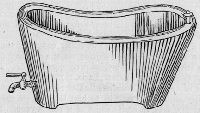
|
Fig 130. Warm tub with double wall jacket. First used by
Denucé in 1857 and Credé in 1860.
|
|
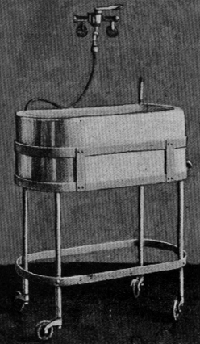
|
Fig. 131. Modified warm tub.
|
|
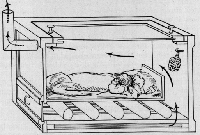
|
Fig 132. Tarnier incubator.
|
|
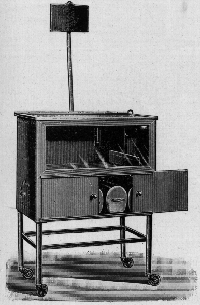
|
Fig 133. Finkelstein incubator.
|
|

|
Fig 134. Reinach heated bed.
|
|
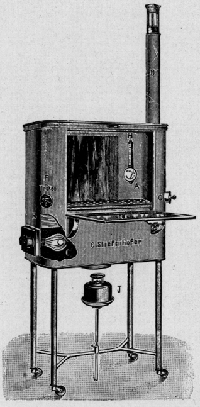
|
Fig 135. Rommel incubator.
|
|
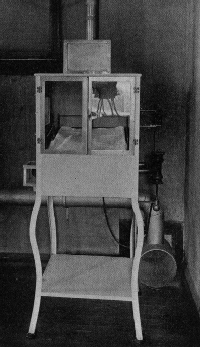
|
Fig 136. Lion-type incubator (Couney model). The fresh
air is forced through a large air shaft by an electric fan
on the outside of the building.
|
|
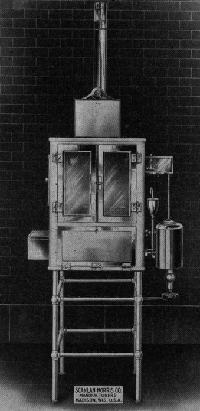
|
Fig. 137. Lion-type incubator. (DeLee model.)
|
|
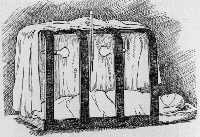
|
Fig. 138. Moll heated bed.
|
|
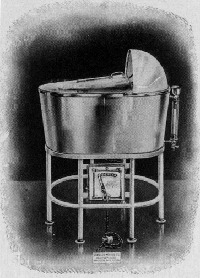
|
Fig. 139. Hess water-jacketed infant bed.
|
|
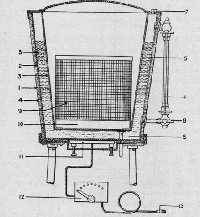
|
Fig. 140. Cross-section of Hess heated bed.
|
|
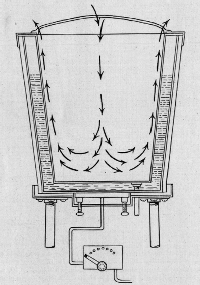
|
Fig. 141. Cross-section of Hess heated bed showing
direction of air currents.
|
|

|
Fig.142. Showing variations in weight curve of an infant
while in and out of a heated bed. The diet was unchanged
between the dates September 19 and October 13.
|
|

|
Fig. 143. Copper receptable containing pad.
|
|
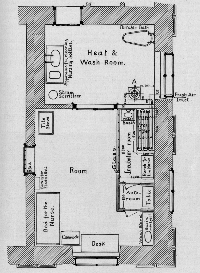
|
Fig 144. Incubator room. Escherich-Pfaundler system.
|
|
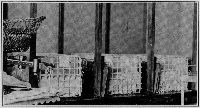
|
Fig. 145. Heated room used as station for the care of
premature infants (University of California, San Francisco,
California). Showing individual cubicles, built on a shelf
running across the room.
|
|
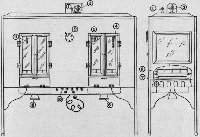
|
Fig. 146. The Sloan Hospital incubator.
|
|
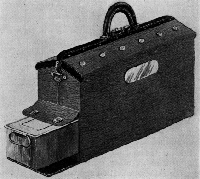
|
Fig. 147. The obstetrical bag with false bottom designed
by the author as a transportation incubator.
|
|
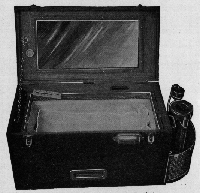
|
Fig. 148. DeLee transportation incubator.
|
|
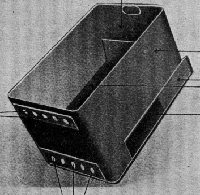
|
Fig. 149. Welde transportation incubator. Inner case.
|
|
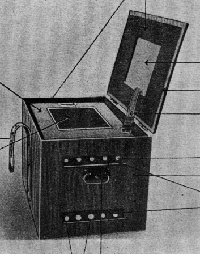
|
Fig. 150. Welde transportation incubator. Outer case.
|
Return to the Hess Contents Page
Created 9/1/98 / Last modified 9/12/98
Copyright © 1998 Neonatology on the Web / webmaster@neonatology.net




















